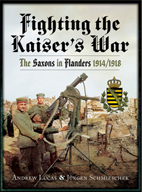Today I wish to introduce an unusual and elusive character who briefly appears in For King and Kaiser, and share some further evidence on the disturbing phenomenon he exemplified.
On 28th October 1914 our featured diarist Major Alfred von Heygendorff (having taken command of Reserve-Infanterie-Regiment Nr.245 in the midst of the ongoing battle, a mere four days earlier) endured "a dreadful day" at Becelaere. The village was subjected to intensive bombardment by the British artillery and many houses set ablaze. The major and his regimental staff took a personal part in dousing a dangerous (small arms) ammunition fire, and were obliged to retire to the cellars of a brewery after surviving a near-miss in their own headquarters. Under the relentless bombardment the entire regiment was forced into cover for the day, leaving "about sixty corpses" from the previous fighting still unburied.
After describing this grim situation at some length, the major changes subject and unexpectedly mentions two of his subordinates who have won his affection:
My current orderly Landwehrmann Müller frets over me most touchingly, he cares for me like a son. Lately I met a 15-year-old boy scout named Fritz Lehmann, who lies in the firing line, joins in the shooting, has a textbook fury toward the English, fetches food and transports the wounded. Now he has got himself a uniform from the dead and received the Iron Cross.
He mentions Lehmann again three days later:
Among the wounded is a 15-year-old boy who has taken a head shot – not my friend Lehmann.
By all law and social convention, these boys should not have been anywhere near the front. The active service requirement established in peacetime was from the age of twenty, and the minimum age for peacetime volunteers was seventeen. Seventeen was also the minimum age for service in the Landsturm, which would subsequently call up many of the less enthusiastic teenagers. As in all combatant nations, many teenagers undoubtedly lied about their age in order to volunteer.
The regimental history of RIR 241 includes a personal account entitled "How I became a Soldier" by one Kurt Keller, who in summer 1914 had been an eager sixteen-year-old would-be infantryman. On 31st August he queued up at the Grenadierkaserne (the barracks of either LGR 100 or GR 101) in Dresden-Albertstadt, only to be rejected as "too young" upon claiming to be seventeen. Soon after he tried again, claimed to be nineteen and was accepted by the same medical officer who had rejected him (so he claims) mere minutes before.
As far as the newly raised RIR 241 and the Saxon military bureaucracy were concerned, Keller was nineteen. There were certainly many more like him among the Kriegsfreiwillige who made up such a large proportion of the XXVII. Reservekorps. The case of Fritz Lehmann however was quite different - not only was he (at least according to one of our sources) a mere fourteen years old, but also universally known to be underage. This was possible because he was not only not officially present at the front, but also not an official member of the armed forces.
Above: Patients from an assortment of units at a field hospital in Flanders, early 1915 (probably during the Second Battle of Ypres). The young man seated on the left in the front row is a Saxon infantryman of RIR 245, sporting the hard-wearing 'Manchesterhose' (corduroy trousers) much favoured by the Württemberg regiments of his division. This is the only photo I know of which shows a Saxon wearing such trousers, despite having amassed hundreds of images from the Saxon elements of the three mixed Saxon / Württemberg divisions (54.RD, 58.ID and 204.ID).
The man standing on the left is another Saxon from IR 105 (30.ID / XV.AK). Note also the Unteroffizier in the back row wearing a captured Belgian cap.
Above: Peacetime pupils of the Saxon Unteroffiziers-Vorschule (NCO preparatory school) in Marienberg, posing in front of a still extant local memorial dating back to the Napoleonic Wars. After completing compulsory education at the age of fourteen, prospective career soldiers (often the sons of the NCO class) could pursue a two year course at this institution, providing general education and physical development. Graduates of the Unteroffiziers-Vorschule could then go on to attend a two-year course at the sister Unteroffiziersschule, a purely military institution (non-graduates of the Vorschule could also apply, but had to complete an additional year). From Unteroffiziersschule the pupils went directly into the army - if successful, already holding NCO rank.
Marienberg remains a garrison town to this day, and is currently the home of the Bundeswehr's Panzergrenadierbataillon 371. My co-author was among many Saxons of his generation who were trained there as conscripts of the NVA (the army of the Soviet satellite state of East Germany).
- Prev
- Next >>








